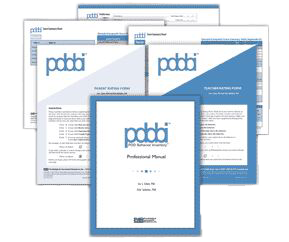(PDDBI) PDD Behavior Inventory
Ages: 1.6 to 18.5 years
Testing Time: 30 to 40 minutes extended forms
20 to 30 minutes standard forms
Administration: Informant report; Individual or group
This informant-based rating scale is designed to assist in the assessment of children who have been diagnosed with autism spectrum disorder (ASD).
Features and Benefits:
Unlike existing assessments for ASD, the PDDBI was developed to assess both problem behaviors as well as appropriate social, language, and learning/memory skills.
Age-standardized scores for parent and teacher ratings are provided.
Test Structure:
The standard set of items is appropriate if the primary concerns are specifically related to autism (e.g., whether treatment is specifically affecting targeted behaviors).
The extended set of items—available on both parent and teacher rating forms—is appropriate when you want to assess aspects of the child’s behaviors beyond those specifically associated with autism (e.g., fear and aggression); these may be relevant in the determination of placement and treatment recommendations.
PDDBI Professional Manual Supplement:
Autism Spectrum Disorder Decision Tree (ASD-DT)
The ASD-DT is designed to enhance the diagnostic power of the PDDBI. Once a parent or teacher has completed the Extended Form, the ASD-DT allows you to use those scores to complete the branches of a decision tree that ultimately results in a diagnostic category. An algorithm is used to transform PDDBI scores into subgroups of ASD (Atypical ASD, Minimally Verbal ASD, or Verbal ASD) as well as non-ASD subgroups. Intervention suggestions and further recommendations are provided for all subgroups. The ASD-DT is designed to be used with individuals ages 1:6 to 12:5 years.
PDDBI Professional Manual Supplement: Adolescent Normative Data
This new supplement extends the age range of the PDDBI normative data to age 18:5 years. Ideal for use when monitoring progress over time, this extension to the normative data can be used with both parent and teacher ratings on the PDDBI. The standardization sample includes individuals from a range of racial and ethnic backgrounds and geographic regions. The adolescent normative data are appropriate for use when either the standard or extended items are administered.
Technical Information:
Standardization sample consisted of 369 parents and 277 teachers of children with well-defined autism from a range of racial/ethnic backgrounds and geographic regions.
Test-retest stability for the teacher ratings ranged from .65 to .99 over an average 2-week interval. For the parent sample, test-retest stability ratings ranged from .38 to .91 over a 12-month interval.
Concurrent validity was assessed through comparison with the Childhood Autism Rating Scale, the Nisonger Child Behavior Scales, the Vineland Adaptive Behavior Scales, and the Griffiths Mental Development Scales.
Clinical validity was assessed through comparison with the ADI-R, the ADOS-G, and the Vineland Adaptive Behavior Scales.
Complete Kit Includes:
PDDBI Professional Manual, PDDBI ASD-DT and Adolescent Normative Data Professional Manual supplements, 25 Parent Rating Forms, 25 Teacher Rating Forms, 25 Parent Score Summary Sheets, 25 Teacher Score Summary Sheets, 50 Profile Forms, 25 ASD-DT Record Forms
User Qualifications Required ... See Order Form Here



